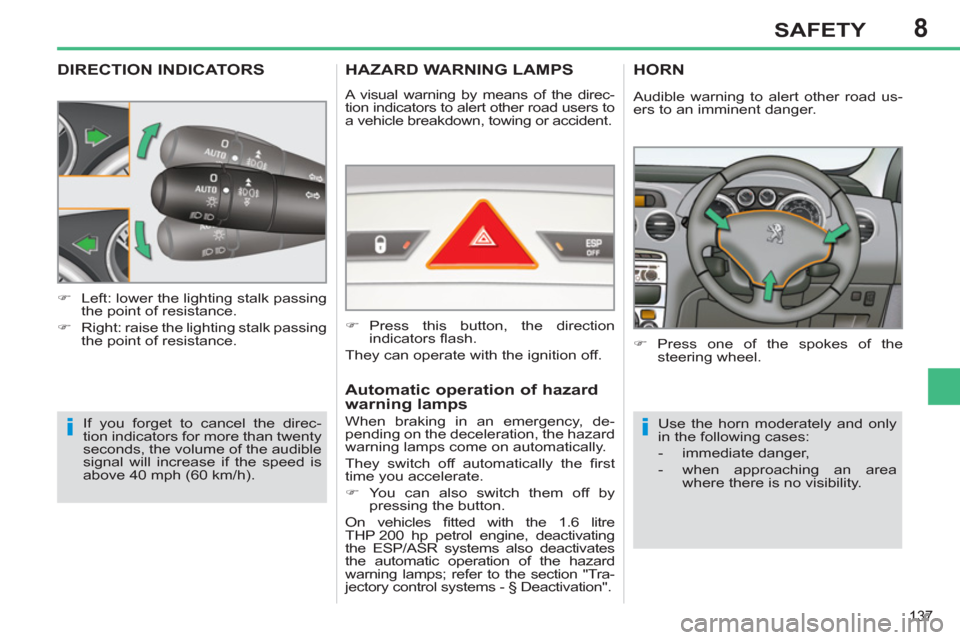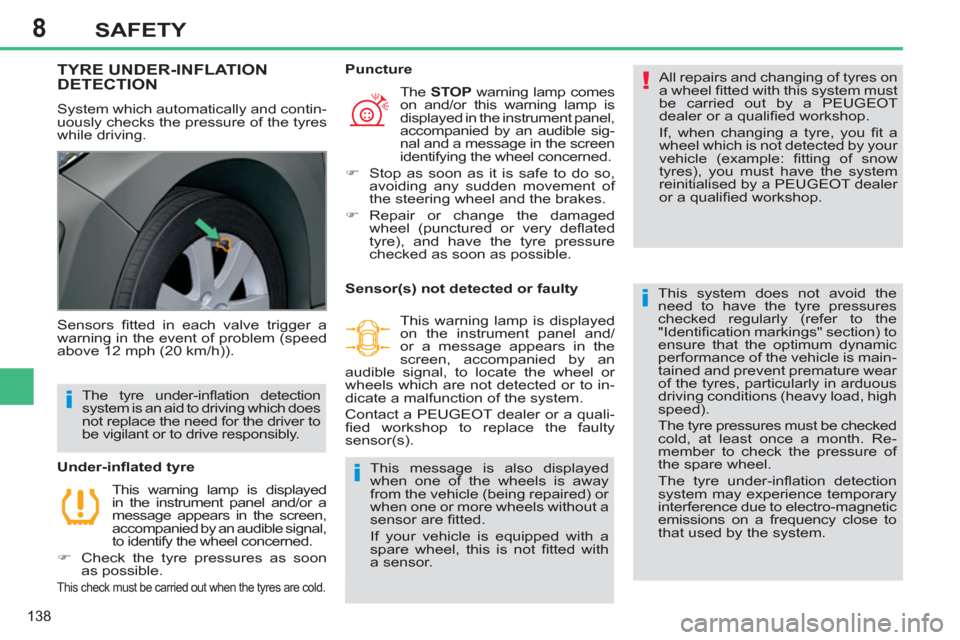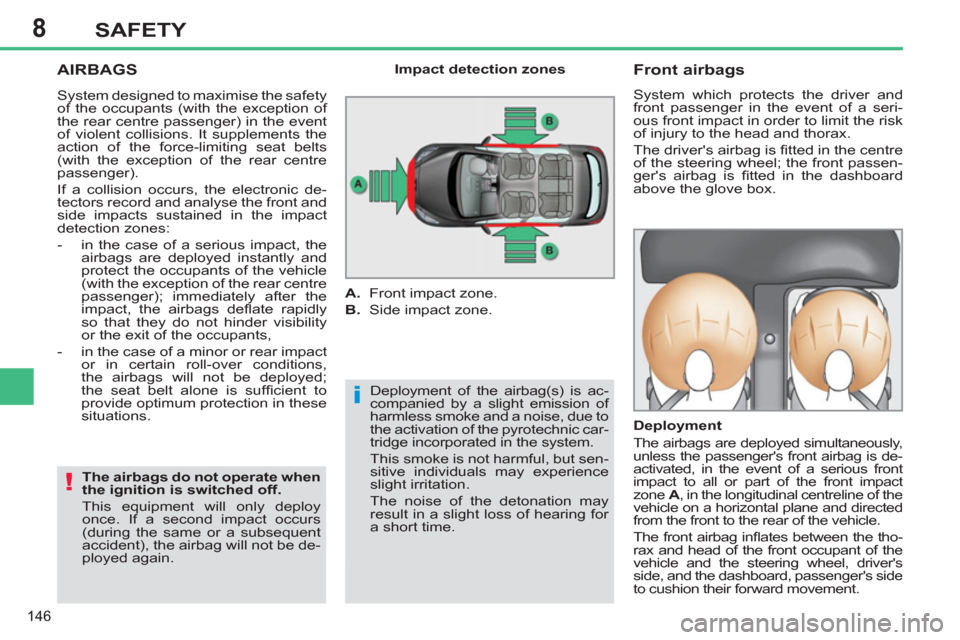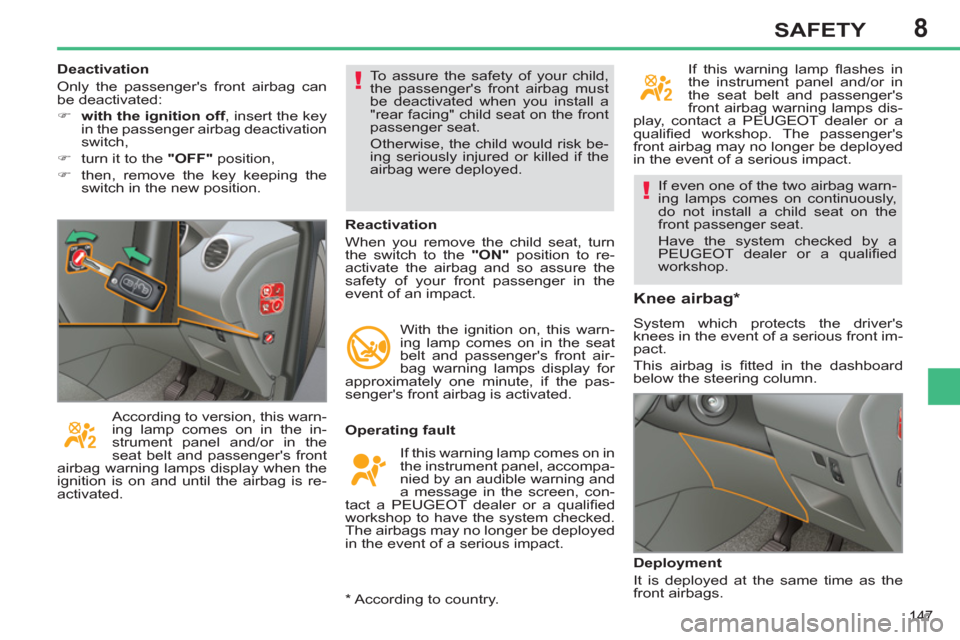2012.5 Peugeot 308 SW BL steering
[x] Cancel search: steeringPage 139 of 382

8
137
SAFETY
DIRECTION INDICATORS
If you forget to cancel the direc-
tion indicators for more than twenty
seconds, the volume of the audible
signal will increase if the speed is
above 40 mph (60 km/h).
�)
Left: lower the lighting stalk passing
the point of resistance.
�)
Right: raise the lighting stalk passing
the point of resistance.
HAZARD WARNING LAMPS
A visual warning by means of the direc-
tion indicators to alert other road users to
a vehicle breakdown, towing or accident.
�)
Press this button, the direction
indicators fl ash.
They can operate with the ignition off.
Automatic operation of hazard
warning lamps
HORN
�)
Press one of the spokes of the
steering wheel.
Use the horn moderately and only
in the following cases:
- immediate danger,
- when approaching an area
where there is no visibility.
Audible warning to alert other road us-
ers to an imminent danger.
When braking in an emergency, de-
pending on the deceleration, the hazard
warning lamps come on automatically.
They switch off automatically the fi rst
time you accelerate.
�)
You can also switch them off by
pressing the button.
On vehicles fi tted with the 1.6 litre
THP 200 hp petrol engine, deactivating
the ESP/ASR systems also deactivates
the automatic operation of the hazard
warning lamps; refer to the section "Tra-
jectory control systems - § Deactivation".
Page 140 of 382

8
138
SAFETY
TYRE UNDER-INFLATIONDETECTION
System which automatically and contin-
uously checks the pressure of the tyres
while driving. All repairs and changing of tyres on
a wheel fi tted with this system must
be carried out by a PEUGEOT
dealer or a qualifi ed workshop.
If, when changing a tyre, you fi t a
wheel which is not detected by your
vehicle (example: fi tting of snow
tyres), you must have the system
reinitialised by a PEUGEOT dealer
or a qualifi ed workshop.
This system does not avoid the
need to have the tyre pressures
checked regularly (refer to the
"Identifi cation markings" section) to
ensure that the optimum dynamic
performance of the vehicle is main-
tained and prevent premature wear
of the tyres, particularly in arduous
driving conditions (heavy load, high
speed).
The tyre pressures must be checked
cold, at least once a month. Re-
member to check the pressure of
the spare wheel.
The tyre under-infl ation detection
system may experience temporary
interference due to electro-magnetic
emissions on a frequency close to
that used by the system.
Sensors fi tted in each valve trigger a
warning in the event of problem (speed
above 12 mph (20 km/h)).
This warning lamp is displayed
in the instrument panel and/or a
message appears in the screen,
accompanied by an audible signal,
to identify the wheel concerned.
�)
Check the tyre pressures as soon
as possible.
This check must be carried out when the tyres are cold.
Under-infl ated tyre The STOP
warning lamp comes
on and/or this warning lamp is
displayed in the instrument panel,
accompanied by an audible sig-
nal and a message in the screen
identifying the wheel concerned.
�)
Stop as soon as it is safe to do so,
avoiding any sudden movement of
the steering wheel and the brakes.
�)
Repair or change the damaged
wheel (punctured or very defl ated
tyre), and have the tyre pressure
checked as soon as possible.
Puncture
The tyre under-infl ation detection
system is an aid to driving which does
not replace the need for the driver to
be vigilant or to drive responsibly.
Sensor(s) not detected or faulty
This warning lamp is displayed
on the instrument panel and/
or a message appears in the
screen, accompanied by an
audible signal, to locate the wheel or
wheels which are not detected or to in-
dicate a malfunction of the system.
Contact a PEUGEOT dealer or a quali-
fi ed workshop to replace the faulty
sensor(s).
This message is also displayed
when one of the wheels is away
from the vehicle (being repaired) or
when one or more wheels without a
sensor are fi tted.
If your vehicle is equipped with a
spare wheel, this is not fi tted with
a sensor.
Page 148 of 382

8
146
SAFETY
AIRBAGS
Deployment of the airbag(s) is ac-
companied by a slight emission of
harmless smoke and a noise, due to
the activation of the pyrotechnic car-
tridge incorporated in the system.
This smoke is not harmful, but sen-
sitive individuals may experience
slight irritation.
The noise of the detonation may
result in a slight loss of hearing for
a short time.
Front airbags
System which protects the driver and
front passenger in the event of a seri-
ous front impact in order to limit the risk
of injury to the head and thorax.
The driver's airbag is fi tted in the centre
of the steering wheel; the front passen-
ger's airbag is fi tted in the dashboard
above the glove box.
Deployment
The airbags are deployed simultaneously,
unless the passenger's front airbag is de-
activated, in the event of a serious front
impact to all or part of the front impact
zone A
, in the longitudinal centreline of the
vehicle on a horizontal plane and directed
from the front to the rear of the vehicle.
The front airbag infl ates between the tho-
rax and head of the front occupant of the
vehicle and the steering wheel, driver's
side, and the dashboard, passenger's side
to cushion their forward movement.
Impact detection zones
A.
Front impact zone.
B.
Side impact zone.
The airbags do not operate when
the ignition is switched off.
This equipment will only deploy
once. If a second impact occurs
(during the same or a subsequent
accident), the airbag will not be de-
ployed again.
System designed to maximise the safety
of the occupants (with the exception of
the rear centre passenger) in the event
of violent collisions. It supplements the
action of the force-limiting seat belts
(with the exception of the rear centre
passenger).
If a collision occurs, the electronic de-
tectors record and analyse the front and
side impacts sustained in the impact
detection zones:
- in the case of a serious impact, the
airbags are deployed instantly and
protect the occupants of the vehicle
(with the exception of the rear centre
passenger); immediately after the
impact, the airbags defl ate rapidly
so that they do not hinder visibility
or the exit of the occupants,
- in the case of a minor or rear impact
or in certain roll-over conditions,
the airbags will not be deployed;
the seat belt alone is suffi cient to
provide optimum protection in these
situations.
Page 149 of 382

8
147
SAFETY
If even one of the two airbag warn-
ing lamps comes on continuously,
do not install a child seat on the
front passenger seat.
Have the system checked by a
PEUGEOT dealer or a qualifi ed
workshop.
Operating fault
If this warning lamp comes on in
the instrument panel, accompa-
nied by an audible warning and
a message in the screen, con-
tact a PEUGEOT dealer or a qualifi ed
workshop to have the system checked.
The airbags may no longer be deployed
in the event of a serious impact.
Knee airbag *
System which protects the driver's
knees in the event of a serious front im-
pact.
This airbag is fi tted in the dashboard
below the steering column.
Deployment
It is deployed at the same time as the
front airbags.
Reactivation
When you remove the child seat, turn
the switch to the "ON"
position to re-
activate the airbag and so assure the
safety of your front passenger in the
event of an impact.
With the ignition on, this warn-
ing lamp comes on in the seat
belt and passenger's front air-
bag warning lamps display for
approximately one minute, if the pas-
senger's front airbag is activated. To assure the safety of your child,
the passenger's front airbag must
be deactivated when you install a
"rear facing" child seat on the front
passenger seat.
Otherwise, the child would risk be-
ing seriously injured or killed if the
airbag were deployed.
According to version, this warn-
ing lamp comes on in the in-
strument panel and/or in the
seat belt and passenger's front
airbag warning lamps display when the
ignition is on and until the airbag is re-
activated. If this warning lamp fl ashes in
the instrument panel and/or in
the seat belt and passenger's
front airbag warning lamps dis-
play, contact a PEUGEOT dealer or a
qualifi ed workshop. The passenger's
front airbag may no longer be deployed
in the event of a serious impact.
Deactivation
Only the passenger's front airbag can
be deactivated:
�)
with the ignition off
, insert the key
in the passenger airbag deactivation
switch,
�)
turn it to the "OFF"
position,
�)
then, remove the key keeping the
switch in the new position.
*
According to country.
Page 151 of 382

8
149
SAFETY
For the airbags to be fully
effective, observe the following
safety rules:
Sit in a normal upright position.
Wear a correctly adjusted seat belt.
Do not leave anything between the
occupants and the airbags (a child,
pet, object...). This could hamper the
operation of the airbags or injure the
occupants.
*
According to country.
Lateral airbags
Use only approved covers on the seats, compatible with the deployment the
lateral airbags. For information on the range of seat covers suitable for your
vehicle, you can contact a PEUGEOT dealer (see "Practical information - § Ac-
cessories").
Do not fi x or attach anything to the seat backs (clothing...). This could cause
injury to the chest or arms if the lateral airbag is deployed.
Do not sit with the upper part of the body any nearer to the door than necessary.
Curtain airbags
Do not fi x or attach anything to the roof. This could cause injury to the head if
the curtain airbag is deployed.
If fi tted on your vehicle, do not remove the grab handles installed on the roof,
they play a part in securing the curtain airbags.
After an accident or if the vehicle has
been stolen or broken into, have the
airbag systems checked.
All work on the airbag system must
be carried out by a PEUGEOT dealer
or a qualifi ed workshop.
Even if all of the precautions men-
tioned are observed, a risk of injury
or of minor burns to the head, chest
or arms when an airbag is deployed
cannot be ruled out. The bag infl ates
almost instantly (within a few mil-
liseconds) then defl ates within the
same time discharging the hot gas
via openings provided for this pur-
pose.
Knee airbag *
Do not sit with your knees any nearer to the steering wheel than necessary.
Front airbags
Do not drive holding the steering wheel by its spokes or resting your hands on
the centre part of the wheel.
Passengers must not place their feet on the dashboard.
If possible, do not smoke as deployment of the airbags can cause burns or the
risk of injury from a cigarette or pipe.
Never remove or pierce the steering wheel or hit it violently.
Page 155 of 382

9DRIVING
6-SPEED ELECTRONIC GEAR
CONTROL GEARBOX
Gear lever
R.
Reverse
�)
With your foot on the brake, move
the lever upwards to select this
position.
N.
Neutral.
�)
With your foot on the brake, select
this position to start.
A.
Automated mode.
�)
Move the lever downwards to select
this mode.
M + / -.
Sequential mode with manual
changing of the gears.
�)
Move the lever downwards then to
the left to select this mode, then:
- push the lever forwards to change
up a gear,
- or pull the lever rearwards to
change down a gear.
S.
Sport function.
�)
Press this button to activate or
deactivate this function.
Steering mounted control paddles
+.
Change up control paddle to the
right of the steering wheel.
�)
Press the back of the "+"
steering
wheel control paddle to change up a
gear.
-.
Change down control paddle to the
left of the steering wheel.
�)
Press the back of the "-"
steering
wheel control paddle to change
down a gear.
The steering wheel control pad-
dles do not permit the selection of
neutral or engaging or disengaging
reverse gear. Six-speed electronic gear control gear-
box which offers a choice between the
comfort of automated operation or the
pleasure of manual gear changing.
Two driving modes are offered:
- automated
mode for automatic
control of the gears by the gearbox,
without any action on the part of the
driver,
- manual
mode for sequential
changing of the gears by the driver
using the gear lever or steering
mounted control paddles.
With each of these two modes, a Sport
function is available for a more dynamic
style of driving.
With the automated mode, you can tem-
porarily take control of gear changing at
any time.
This gearbox provides you with additional
functions:
- hill start assist,
- creep * (movement of the vehicle
on releasing the brake pedal) in
automated mode or reverse.
*
Model fi tted with the 1.6 litre e-HDi
PEF 112 hp Diesel engine.
Page 157 of 382

9
155
DRIVING
Temporary manual control of gear
changing
You can temporarily take over control
of gear changing using the steering
mounted "+" and "-" control paddles: if
the engine speed allows, the request to
change gear is accepted.
AUTO
and the gear engaged
is displayed in the instrument
panel. When braking or slowing down, the
gearbox changes down automatically
so that the vehicle picks up in the cor-
rect gear.
On sharp acceleration, the gearbox will
not change up unless the driver acts on
the gear lever or the steering mounted
control paddles.
The gears engaged appear in
succession in the instrument
panel screen.
Manual mode
�)
Select position M
.
Sport function
�)
Following selection of the manual
mode or automated mode, press
button S
to activate the Sport
function which offers you a more
dynamic style of driving. Never select neutral N
when the
vehicle is moving.
It is possible to change mode at
any time, by moving the gear lever
from A
to M
or from M
to A
.
This function allows you to anticipate
certain situations such as overtaking
another vehicle or approaching a bend.
After a few moments without any ac-
tion on the control paddles, the gearbox
starts managing gear changes auto-
matically again.
S
appears next to the gear en-
gaged in the instrument panel
screen.
�)
Press button S
again to deactivate
the function.
S
is then cleared from the instrument
panel screen.
Reverse
To engage reverse, the vehicle must be
stationary, with your foot on the brake
pedal.
�)
Select position R
.
At very low speed, if reverse gear is re-
quested, this will only be taken into ac-
count when the vehicle is immobilised.
The Foot on the brake pedal
warning
lamp comes on in the instrument panel
to encourage you to brake.
At high speed, if reverse gear is re-
quested, the N
indicator lamp will fl ash
and the gearbox will change to neutral
automatically. To engage a gear again,
return the lever to position A
or M
.
The gear change requests are only car-
ried out if the engine speed permits.
It is not necessary to release the accel-
erator during gear changes.
Hill start assist
This function allows temporary immobi-
lisation of your vehicle.
It maintains the pressure of the brakes
briefl y, long enough for you to move
your foot from the brake pedal to the
accelerator pedal.
It comes into operation if the vehicle is
immobilised by pressing the brake ped-
al and depending on the gradient:
- on an ascending gradient, with
the vehicle stationary, gear lever
in position A
or M
, the vehicle is
held briefl y when the brake pedal is
released,
- on a descending gradient, with the
vehicle stationary, gear lever in
position R
, the vehicle is held briefl y
when the brake pedal is released. The Sport function is deactivated
each time the ignition is switched
off.
Page 162 of 382

9
160
DRIVING
STOP & START
The Stop & Start system puts the engine
temporarily on standby - STOP mode -
during stops in the traffi c (red lights, traf-
fi c jams, or other...). The engine restarts
automatically - START mode - as soon as
you want to move off. The restart takes
place instantly, quickly and silently.
Perfect for urban use, the Stop & Start
system reduces fuel consumption and
exhaust emissions as well as the noise
level when stationary.
Operation
Going into engine STOP mode
The "ECO"
warning lamp comes
on in the instrument panel and the engine goes into standby:
- with a manual gearbox
, at speeds
below 12 mph (20 km/h), when you
put the gear lever into neutral and
release the clutch pedal,
- with the 6-speed electronic gear
control gearbox
, at a speed below
5 mph (8 km/h), when you press the
brake pedal or put the gear lever
into position N
. If your vehicle is fi tted with
the system, a time counter
calculates the sum of the
periods in STOP mode dur-
ing a journey. It rests itself to
zero every time the ignition
is switched on with the key.
With the automatic gearbox system, for your comfort during parking ma-
noeuvres, STOP mode is not avail-
able for a few seconds after coming
out of reverse gear.
STOP mode does not affect the
functionality of the vehicle, such as
braking, power steering, for example.
Never refuel with the engine in
STOP mode; you must switch off
the ignition with the key.
Special cases: STOP mode
unavailable
STOP mode is not invoked when:
- the driver's door is open,
- the driver's seat belt is not fastened,
- the vehicle has not exceeded 6 mph
(10 km/h) since the last engine start
using the key,
- the engine is needed to maintain
a comfortable temperature in the
passenger compartment,
- demisting is on,
- some special conditions (battery
charge, engine temperature, braking
assistance, ambient temperature...)
where the engine is needed to assure
control of a system.
In this case, the "ECO"
warning
lamp fl ashes for a few seconds,
then goes off.
This operation is perfectly normal.